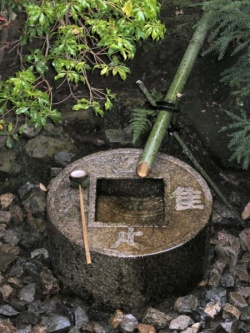Difference between revisions of "Tsukubai"
(Created page with "thumb|250px|Tsukubai at [[Ryōan-ji temple in {{Wiki|Kyoto}}]] A tsukubai (蹲踞?) is a small basin provided in Japanese Buddhist temples for v...") |
|||
| Line 1: | Line 1: | ||
| − | [[File:Tsukubai2.JPG|thumb|250px|Tsukubai at [[Ryōan-ji]] temple in {{Wiki|Kyoto}}]] | + | [[File:Tsukubai2.JPG|thumb|250px|Tsukubai at [[Ryōan-ji]] [[temple]] in {{Wiki|Kyoto}}]] |
| − | A [[tsukubai]] ([[蹲踞]]?) is a small basin provided in Japanese Buddhist temples for visitors to purify themselves by the ritual washing of hands and rinsing of the mouth (perform ablutions). This type of ritual cleansing is also the custom for guests attending a tea ceremony. | + | A [[tsukubai]] ([[蹲踞]]?) is a small basin provided in [[Japanese Buddhist]] [[temples]] for visitors to {{Wiki|purify}} themselves by the [[ritual]] washing of hands and rinsing of the {{Wiki|mouth}} (perform ablutions). This type of [[ritual]] cleansing is also the {{Wiki|custom}} for guests attending a tea {{Wiki|ceremony}}. |
| − | [[Tsukubai]] are usually of stone, and are often provided with a small scoop, laid across the top, ready for use. A supply of water is provided via a bamboo pipe called a kakei. | + | [[Tsukubai]] are usually of stone, and are often provided with a small scoop, laid across the top, ready for use. A supply of [[water]] is provided via a {{Wiki|bamboo}} pipe called a kakei. |
| − | The tsukubai shown here, from the Ryōan-ji temple, is famous for the inscribed poem. The kanji written on the surface of the stone are without significance when read alone. If each is read in combination with 口 (kuchi), which the central bowl is meant to represent, then the characters become 吾, 唯, 足, 知. This is read as "ware tada taru (wo) shiru" and translates literally as "I only know plenty" (吾 = ware = I, 唯 = tada = only, 足 = taru = plenty, 知 = shiru = know). The meaning, "what one has is all one needs", is meant to reinforce the basic anti-materialistic teachings of Buddhism. There are also possible connection with Daodejing or Tao Te Ching (look poem nr. 33). | + | The tsukubai shown here, from the [[Ryōan-ji]] [[temple]], is famous for the inscribed poem. The [[kanji]] written on the surface of the stone are without significance when read alone. If each is read in combination with 口 (kuchi), which the central [[bowl]] is meant to represent, then the characters become 吾, 唯, 足, 知. This is read as "ware tada taru (wo) shiru" and translates literally as "I only know plenty" (吾 = ware = I, 唯 = tada = only, 足 = taru = plenty, 知 = shiru = know). The meaning, "what one has is all one needs", is meant to reinforce the basic anti-materialistic teachings of [[Buddhism]]. There are also possible connection with {{Wiki|Daodejing}} or [[Tao Te Ching]] (look poem nr. 33). |
{{W}} | {{W}} | ||
Revision as of 08:30, 6 February 2014
A tsukubai (蹲踞?) is a small basin provided in Japanese Buddhist temples for visitors to purify themselves by the ritual washing of hands and rinsing of the mouth (perform ablutions). This type of ritual cleansing is also the custom for guests attending a tea ceremony.
Tsukubai are usually of stone, and are often provided with a small scoop, laid across the top, ready for use. A supply of water is provided via a bamboo pipe called a kakei.
The tsukubai shown here, from the Ryōan-ji temple, is famous for the inscribed poem. The kanji written on the surface of the stone are without significance when read alone. If each is read in combination with 口 (kuchi), which the central bowl is meant to represent, then the characters become 吾, 唯, 足, 知. This is read as "ware tada taru (wo) shiru" and translates literally as "I only know plenty" (吾 = ware = I, 唯 = tada = only, 足 = taru = plenty, 知 = shiru = know). The meaning, "what one has is all one needs", is meant to reinforce the basic anti-materialistic teachings of Buddhism. There are also possible connection with Daodejing or Tao Te Ching (look poem nr. 33).
